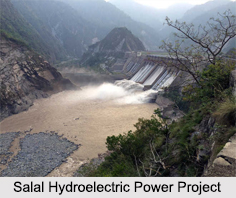 Salal Project, also known as Salal Hydroelectric Power Station, is a run-of-the-river power project on the Chenab River in Reasi District of Jammu and Kashmir. This was the first hydropower project, which was built by India under the Indus Water Treaty regime in Kashmir. It was constructed after the agreement between India and Pakistan in 1978. It took almost five years to build the dam. Jammu and Kashmir receives 12.5 percent of the energy generated from the project. The rest is transmitted to the Northern Grid where it is distributed to the states of Punjab, Haryana, Delhi, Himachal Pradesh, Rajasthan and Uttar Pradesh. Jammu and Kashmir also purchases additional power at regular prices.
Salal Project, also known as Salal Hydroelectric Power Station, is a run-of-the-river power project on the Chenab River in Reasi District of Jammu and Kashmir. This was the first hydropower project, which was built by India under the Indus Water Treaty regime in Kashmir. It was constructed after the agreement between India and Pakistan in 1978. It took almost five years to build the dam. Jammu and Kashmir receives 12.5 percent of the energy generated from the project. The rest is transmitted to the Northern Grid where it is distributed to the states of Punjab, Haryana, Delhi, Himachal Pradesh, Rajasthan and Uttar Pradesh. Jammu and Kashmir also purchases additional power at regular prices.
History of Salal Project
The initiative of the Sala Project was taken in the year 1920 and research started in 1961 by the Government of Jammu and Kashmir. Salal Project was designed in 1968. Construction of the dam started from 1970 by Central Hydroelectric Project Control Board.
Construction of Salal Project
After the agreement in 1978, the construction of the project was entrusted to National Hydroelectric Power Corporation (NHPC). The Stage-I of the powerhouse was commissioned in 1987; Stage-II between 1993 and 1995. The final commissioning of the project took place in 1996. After the completion of the project, it was transferred to NHPC for the ownership.
Structure of Salal Project
Salal Dam is 130 meters high with an elevation of 1627 feet above mean sea level, a 40 feet gated spillway at the top and six under-sluices at an elevation of 1365 feet. Due to Pakistan"s insistence, the under-sluices were permanently plugged with concrete. The gates were also reduced from 40 feet to 30 feet.
This article is a stub. You can enrich by adding more information to it. Send your Write Up to content@indianetzone.com.



















